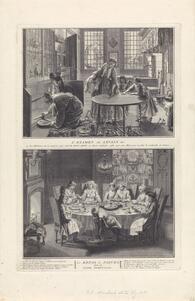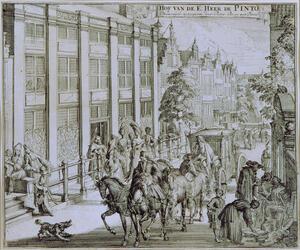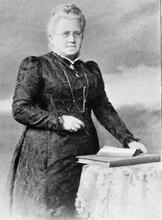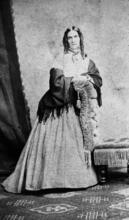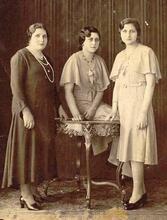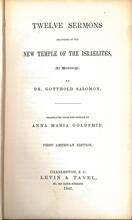Sephardi Women in the Dutch Republic
The early modern Dutch Sephardic community consisted mostly of former New Christians who turned into New Jews when they left the Iberian peninsula and persecution by the Inquisition. Women of this community were not often visible in the public domain, mostly due to the influence of Spanish-Arab culture. They arrived in the Republic in extended families, or as singles and heads of broken families. Some were wealthy, others suffered great poverty. While many New Christian women had been instrumental in secretly transferring Jewish tradition from one generation to the next, they knew little about normative Judaism and had to be re-educated upon arrival, mostly by word of mouth or by reading compendia of Jewish traditions. Many women were active on the Dutch labor market, and they played a central role within the household and were actively involved in communal life.
Introduction
One of the tombstones in the Portuguese Jewish cemetery at Ouderkerk aan de Amstel is the that of Esther de la Penha. Esther died in 1697. On her tombstone is a carving of a house, not only referring to her family’s residence in Rotterdam, but also metaphorically pointing at her place in society—and by extension, at that of Dutch Descendants of the Jews who lived in Spain and Portugal before the explusion of 1492; primarily Jews of N. Africa, Italy, the Middle East and the Balkans.Sephardi women in general. Psalm 128:3, also included on the tombstone, alludes to this place in society as well: “Thy wife shall be as a fruitful vine in the innermost part of thy house.”
Travelers to the Portuguese community of Amsterdam in the seventeenth century were struck by the fact the male members kept their females withdrawn and out of the public eye as much as possible. This custom may have stemmed from the influence of Arab culture on Spanish society, as women in Spain, like those in the Arab world, were heavily protected and kept from the public eye.
This tradition was transferred to the north when Conversos, or New Christians, fled the Iberian Peninsula and persecutions by the Spanish and Portuguese Inquisitions. In addition to Italy, North Africa, and the Ottoman Empire, a new destination in northern Europe appeared on the horizon by the end of the sixteenth century. There, a fierce fight for independence was fought against Spain and Catholicism. In 1588, the so-called Republic of the Seven United Netherlands was founded, in which freedom of religious conscience was the leading principle; the Dutch Republic lasted until 1795. Despite the fact that the Reformed (Calvinist) Church became the privileged church, it was a relatively tolerant place for other religious denominations. Besides, the Dutch Republic had developed into one of the leading economic centers of the world, with Amsterdam as its guiding star. It was also there and then that New Christians from Spain and Portugal could return to the faith of their forefathers.
Through their flight, the refugees changed not only their place of residence but also their identity. For generations they had lived as forced converts in Spain and Portugal, ever since the expulsion of Jews from Spain in 1492 and the forced conversion of Jews in Portugal in 1497, often hiding their Jewish identity and celebrating Judaism in secret. After more than a century of suppression, the Dutch Republic gave them the opportunity to become so-called New Jews and live a free life with public Jewish worship. Thus they built a community that soon became a leading center in the Jewish world and acquired renown for its wealth and benevolence.
Yet, despite their new identity, many Sephardim, or “Portuguese” as they were called, remained influenced by Spanish tradition, including their attitude towards women. It was in striking contrast to the famous freedom of movement enjoyed by non-Jewish women in the Dutch Republic. Nevertheless, the voices of Sephardi women can be heard in many surviving documents and objects, such as contracts, wills, inventories, petitions, and gifts to the community.
Numbers
Despite the fact that few Portuguese women could be seen in the street, Sephardi women were omnipresent from the time of the establishment of the Portuguese Dutch community in the sixteenth century. Yet it is difficult to determine their number. During the early modern period, the Amsterdam Portuguese community grew to around 5,000 individuals; by the end of the eighteenth century only 4,000 were left. (TheJews of European origin and their descendants, including most of North and South American Jewry.Ashkenazi community overshadowed the Portuguese in numbers by the beginning of the eighteenth century, increasing to 20,000 individuals by 1795.) The Sephardi women who appeared on the communal charity rolls can be easily counted and certainly formed a majority; adding the women married to most of the males mentioned in the communal tax registers, one can conclude that women actually formed a majority of the Sephardi community of the Dutch Republic.
Migration
Many women arrived in the Dutch Republic in complete households, often accompanied by servants. Other families sent male heads of households first to examine the new abode before their spouses and children made the trip. Many women also arrived as singles (unmarried, orphaned, or widowed) or as heads of broken family units, with children, grandchildren, nieces, and nephews. For some who were married, their husbands may have had no intention of joining them or were travelling elsewhere. Others left their male partners behind in the Inquisition’s prisons or, even worse, at the stake. Some had lost track of their husbands and arrived in search of them, not knowing whether they were dead or alive.
Most Conversas came from Spain, Portugal, and France, but Sephardi women also arrived from North Africa, Italy, the Balkans, or the Levant, often fleeing pogroms. Their migration from faraway places stands in striking contrast to the flow of other women, most of whom arrived from much nearer by.
Once in the Dutch Republic, Sephardi women were often left alone when their husbands and/or children travelled abroad or settled abroad permanently. Emigration was predominantly male, although women did occasionally leave, to return home or to migrate to other centers of the Jewish world. High mobility, for Jews and non-Jews, was a normal phenomenon in early modern Europe and greatly influenced the lives of Sephardi women.
Religious Identity
On the Iberian Peninsula, many New Christian women had been instrumental in secretly transferring Jewish tradition from one generation to the next. Nevertheless, their knowledge of normative Judaism was quite limited and they had to be re-educated upon arrival, transforming from New Christians into so-called New Jews.
Contrary to their male counterparts, however, no study circles or religious schools were open to women. Instruction must have been taken place by word of mouth or by reading compendia of Jewish traditions. The last section of such a compendium, the Thesovro dos Dinim by Haham Menasseh ben Israel, published in 1647, was devoted to women arriving from the Peninsula. Aware of the lack of opportunities for female re-education, Menasseh not only introduced women to Jewish matrimonial laws, he also instructed them how to keep a Term used for ritually untainted food according to the laws of Kashrut (Jewish dietary laws).kosher household and stressed modesty and humility.
The female transition to normative Jewish life encountered many obstacles and the rabbinic establishment often expressed its disapproval of female conduct. Yet Sephardi women did ultimately integrate into the bosom of the Jewish community. They attended synagogue and celebrated Jewish holidays, and the presence of ceremonial objects and prayer books in many Sephardi households points at active Jewish practice. Many women promoted the study of Judaism by joining religious societies and providing scholarships, such as to the famous Ets Haim Yeshiva. Women often expressed their ethnic-religious pride in belonging to the Spanish Portuguese Jewish nation in their wills. Legacies to the synagogue or to charitable and religious brotherhoods, in cash or in the form of objects, like Torah she-bi-khetav: Lit. "the written Torah." The Bible; the Pentateuch; Tanakh (the Pentateuch, Prophets and Hagiographia)Torah scrolls and silver objects, confirm their dedication to their newly recovered identity and successful integration into the Jewish mainstream.
Deviance
In the absence of men, many women were left to the supervision of the Portuguese community or of their family and friends. To avoid women being exposed to dangerous company and to protect their honor, the Sephardi community issued rulings forbidding women from going out unaccompanied late at night or in the early morning or, with a few defined exceptions, from visiting the synagogue at those hours. Couples were not supposed to marry without their parents’ consent. Married women were not allowed to receive men at home while their husbands were away. Charitable and social societies demanded impeccable honorable behavior of their applicants. Moreover, conversion to the Reformed Church or relapse into Catholicism was strongly opposed. The strict rules for women, a natural consequence of their former Iberian environment, led some women to try to escape the suffocating atmosphere, even going so far as to leave the community altogether. The percentage of Portuguese Jewish women living at the margins of Dutch society remained small, however, and only a few sank as low as making a living as prostitutes, although a handful became involved in crime.
Work
Although the protective atmosphere surrounding them did not prevent Sephardi women from being active in the Dutch labor market, they did not participate in all occupations. Portuguese Jews had generally refrained from dirty handwork, as quite a few New Christians in Spain and Portugal had been accustomed to employing servants. Dutch Sephardim thus often employed Dutch people, Ashkenazim, Italian Jews, moriscos, mulattos, or Black people for household jobs or in and around the synagogue. For the same reasons, Dutch Sephardi women mostly avoided working with the sick, and had similar people fill these jobs as well, as did refugees from the eastern Sephardi diaspora (those who had migrated mostly the Ottoman Empire). Only in the eighteenth century did a few women of western Sephardi origin take up these less popular tasks, if they had no other means of survival. Sephardi women who worked as servants generally held more “honorable” positions, such as chambermaids, housekeepers, or cooks.
Jobs requiring knowledge of normative Jewish life (such assisting in the ritual bath or supervising the baking of kosher bread) were mostly reserved for women born into an Orthodox rabbinic milieu, as former Conversas were seen as either insufficiently acquainted with the laws of normative Judaism or not obeying them seriously enough. Ex-Conversas did find employment making shrouds, assisting in the distribution of charity to the poor, or helping their husbands in the medical profession. They also often maintained family businesses in retail, crafts, or industry until children or their spouses could take them over. International trade was often continued by merchants’ widows. Sephardi women also found work in their own right, running grocery and tobacco shops, offering lodging, or knitting and sewing simple clothing. The ever-growing number of charitable organizations and institutions, especially in the eighteenth century, also offered work opportunities. As wealthy Sephardim in general retreated from active economic life during the eighteenth century, living mostly as rentiers, their widows, unlike their Ashkenazi counterparts, did so, too, becoming mainly preoccupied with investing their assets and renting out their real estate.
Education
Just as there were no religious schools for girls, no educational institutions existed to teach Sephardi girls basic skills of reading and writing or to train them for professions. Education must have taken place privately at home, especially since the Portuguese community claimed that “according to the customs of Portugal” its girls were not supposed to go into the streets. Girls from well-to-do families had teachers to instruct them; among them, the rate of literacy was relatively high, and a few women even became poets. Some Sephardi women could read and write Dutch in addition to Spanish and Portuguese, and musical education was part of the curriculum for wealthy families. Instruction in the basics of normative Jewish tradition must have taken place at home, where mothers taught the basic rules of Jewish law. Women from rabbinic families or Ashkenazi personnel might also have been hired as instructors.
In contrast, many women, especially those from less fortunate milieus, could not write even their first names. The curriculum of the girls’ orphanage attests to Jewish education given to poor girls, as besides instruction in sewing and knitting, it contained a program to learn to live in “fear of God.” In their wills, testators also often left instructions to their offspring to live as God-fearing persons. The presence of prayer books and Bibles in Spanish and the absence of Hebrew works in female possession indicate that knowledge of Hebrew likely remained low for both rich and poor women.
Despite the lack of formal professional training, some women must have been introduced into basic medical practice, taught by their fathers/mothers or by their husbands. They thus served as assistants to surgeons, barbers, and pharmacists, or as midwives in their own right.
Family Life
Quite a few documents, such as wills, testify to an intense family life in which Sephardi women played a central role within the household, responsible for running the home and for the education and rearing of children. Newly married couples often found homes with their parents or parents-in-law, as was common in Jewish tradition. Families also often took in individuals awaiting the arrival of their loved ones or looking for company or affordable housing with family or friends. Widows often lived with their children or opened their homes to other members of their families.
The actual extent of hospitality was debatable, as some, including rabbis, complained that wealthy Sephardim were aloof from people not of their socio-economic class or ethno-religious group. Yet there was warmth at home: husbands and wives often voiced feelings of love towards their spouses, children, and friends. Besides, families expressed great joy upon the arrival of relatives from other parts of the world, especially those from the Iberian Peninsula who were victims of the Inquisition; sadness prevailed when family members remained prisoners in Spain or Portugal or were otherwise unable or unwilling to immigrate.
According to a family’s financial capacity, girls were provided with dowries and trousseaus. Poor Sephardi women could receive dowries from the Amsterdam-based international dowry society Dotar or through private dowry donations or foundations, often established at female initiative.
The wealthy, including women, made strong efforts to find their children, grandchildren, or nephews and nieces partners who would meet the family’s business and capital needs. For needy girls, it was much more difficult to find spouses, despite dowries made available. The surplus of female candidates was just too overwhelming.
As in non-Jewish circles, little attention was paid to romantic love and marriages served primarily social-economic interests. By the later part of the eighteenth century, this situation had begun to change, in both Jewish and non-Jewish circles.
Despite the fact that servants were present in quite a few Sephardi households, it is difficult determine emotional attitudes towards them. Some documents show they were included in family life and appreciated. Other sources offer different insights.
Social and Communal Life
Besides their work at home or in the business, quite a few women were actively involved in communal life, joining social, literary, and charitable societies. However, unlike in the Ashkenazi community or in Dutch society, Sephardi women did not initiate such societies, nor did they serve in important management positions, such as treasurer, let alone have voting rights. Nevertheless, they had strong connections to these societies, as evidenced by the fact that they often left them legacies in wills. Mutual aid societies were especially popular, as they provided protection in times of widowhood, illness, and old age and took care of all provisions around death and burial. These organizations functioned as a form of insurance, preventing middle-class Sephardi women from becoming dependent on charity.
Many new societies attuned to the needs of Sephardi women sprang up, especially in the eighteenth century when the Sephardic community’s economic position deteriorated. In this period, the community’s elaborate public welfare system could no longer cope with the load of poverty and private institutions were established to fill the void.
Sephardi women also enjoyed a rich social life. They visited friends, entertained at home, and watched Spanish comedies in theaters. They also celebrated Jewish holidays and Jewish life cycle events with their family and friends, displaying pride in their newly recovered open Jewish life.
Material Culture
Inventories provide us a closer look at family life in the domestic realm, albeit mostly for the more well-to-do. These inventories prove that Portuguese Jews’ identity was diverse, stemming from a variety of cultures. Furniture, ceramics, clothing, and libraries indicate that Sephardi families stayed very much connected to Spanish influence. Often they had brought their household goods north with them or had them shipped afterwards. As an international market, Amsterdam also offered objects produced on the Iberian Peninsula. Sephardim, including women, were also well integrated into Dutch and European culture; with East Indian chests, Turkish carpets, French gueridons, Blaeu globes, and paintings of landscapes, royal families, or historical scenes in their rooms and on their walls, their homes were similar to those of their wealthy neighbors at home and abroad. Moreover, the above-mentioned presence of Jewish ceremonial objects and books, including those belonging to women, points at a successful adaptation to their new Jewish sphere. Objects—such as the jewelry, silver, gold, and valuable fabrics brought in as part of the dowry—had both emotional and economic value; they formed a guarantee in less prosperous times.
Epilogue
Perhaps the only common denominator among Sephardi woman in the Dutch Republic is that most were actively involved in communal life and contributed to the Dutch and international economies. While depictions of Dutch Sephardi women portray wealthy ladies dressed in exuberant clothes in their homes, strolling through the streets, or being transported in their chic horse-drawn coaches, most women were from the middle and lower classes. Some were old, some young, some were married, some single. Some had a Converso background, others did not. Some were first-generation immigrants, others were well integrated into Dutch society. Women could arrive with extended households, by themselves, or in small broken families testifying to the horrors of the Inquisition. Some had sincere religious reasons for moving to a place with the possibility of open Jewish worship; others joined the community for socio-economic reasons. Amsterdam was attractive as a world economic center, and so was the city’s Portuguese community, well known for its extensive network of charitable assistance for those who could not exist on income or wealth only. Some lived in large mansions on one of the beautiful canals, others in small rooms or cellars in cramped streets and alleys in the former Jewish quarter. Some invested their capital in bonds and shares and rented out their real estate; others could survive only on public and private charity and by accepting humble jobs. Upward social mobility remained low, and the gap between the upper and the lower classes grew wider over time.
The cemetery of the Portuguese community witnesses it all: beside the beautiful gravestone of a woman like Esther de la Penha are those with nothing but simple texts. Next to a gravestone like that of Sara Pereira, who died in 1692, adorned with a text recounting her motives for moving from the Iberian Peninsula to a “liberated country,” are graves of women who died leaving no traces, neither on their tombstones nor in surviving documents. Nevertheless, a variety of types of evidence enable us to tell the fascinating and diverse story of Sephardi women in the Dutch Republic.
Levie Bernfeld, Tirtsah. “Balkan Sephardim in Amsterdam.” In Caminos de leche y miel. Jubilee Volume in Honor of Michael Studemund-Halévy, vol. I, edited by H. den Boer, A.Menny, C. L. Wilke, 328-362. Barcelona: Tirocinio, 2018.
Levie Bernfeld, Tirtsah. Dowries and Dotar. An Unbroken Chain of 400 Years. Essay written on the 400th Anniversary of the Amsterdam-based Portuguese Jewish Bridal Society Santa Companhia de Dotar Orphas e Donzellas. Amsterdam: Menasseh ben Israel Institute; Jewish Historical Museum; Dotar: 2015.
Levie Bernfeld, Tirtsah. “Masters, Maids, and Mistresses. Aspects of Domestic Life among the Portuguese Jews in the Seventeenth-Century Dutch Republic.” In Sefardische Perspektiven/Sephardic Perspectives, edited by Sina Rauschenbach, 11-40. Leipzig: Jahrbuch Selma Stern Zentrum für Jüdische Studien Berlin-Brandenburg, 2020.
Levie Bernfeld, Tirtsah. “Matters Matter, Material Culture of Dutch Sephardim (1600-1750).” Studia Rosenthaliana 44 (2012): 191-216.
Levie Bernfeld, Tirtsah. Poverty and Welfare among the Portuguese Jews in Early Modern Amsterdam. Oxford: Littman Library of Jewish Civilization, 2012.
Levie Bernfeld, Tirtsah. “Religious Life among Portuguese Women in Amsterdam's Golden Age.” In The Religious Cultures of Dutch Jewry, edited by Y. Kaplan and D. Michman, 57-99. Leiden/Boston: Brill, 2017.
Levie Bernfeld, Tirtsah. “A Sephardic Saga in the Dutch Republic: The Cohen Pallache Women on Love, Religion and Social Standing.” In Religious Changes and Cultural Transformations in the Early Modern Western Sephardic Communities, edited by Yosef Kaplan, 195-227. Leiden/Boston: Brill, 2019.
Levie Bernfeld, Tirtsah. “Sephardi Women in Holland’s Golden Age,” In Sephardi Family Life in the Early Modern Period, edited by Julia R. Lieberman, 177-222. Waltham, MA: Brandeis University Press, 2010.






